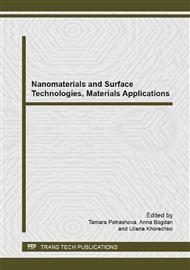[1]
Kobayasi N. Introduction to Nanotechnology. Moscow, BINOM, 2-edition. 2008. p.140.
Google Scholar
[2]
Pul F. Owens. Nanotechnologies. Moscow, Technosphere, 2005. 325 p.
Google Scholar
[3]
Davydovich V.I. Development of technological process and equipment for electroexplosive production of metal powders with low electric conductivity. PhD Thesis. Tomsk, 1986. 254 p.
Google Scholar
[4]
Yavorovskiy N.A. Production of ultradispersed powders by the method of electric explosion. Russian Physics Journal, 1994, No. 4. P. 114-136.
Google Scholar
[5]
Yu. A. Kotov. The Electrical Explosion of Wire: A Method for the Synthesis of Weakly Aggregated Nanopowders. Nanotechnologies in Russia, 2009, Vol. 4, Nos. 7–8, P. 415-424.
DOI: 10.1134/s1995078009070039
Google Scholar
[6]
Yavorovskiy N.A. Pustovalov A.V. Selection of parameters for electric explosion of aluminum and iron wires in argon atmosphere. Russian Physics Journal, 2013, Vol. 56, No. 7/2, P. 164-169.
Google Scholar
[7]
B. Bora, C.S. Wong, H. Bhuyan, Y.S. Lee, S.L. Yap, M. Favre. Understanding the mechanism of nanoparticle formation in wire explosion process. Journal of Quantitative Spectroscopy & Radiative Transfer. №117, 2013, pp.1-6.
DOI: 10.1016/j.jqsrt.2012.11.018
Google Scholar
[8]
Levashova A.I., Kravtsov A.B., Yavorovky N.A., and others. The method for production of ultradispersed catalyst for hydrocarbon – carbon monoxide and hydrogen synthesis. SU Patent No. 1370861, A1, B 01 J 37/34.
Google Scholar
[9]
Galanov A.I., Urmazova T.A., Saveliev G.G., and others. Development of magnetically controlled system for chemotherapeutic agents delivery on the basis of nano-sized iron particles. Siberian oncologic journal. - 2008. №3 (27). - pp.50-57.
Google Scholar
[10]
Pustovalov A. Study of Products of Electrical Explosion of Iron Wires in an Argon-Oxygen Mixture. Advanced Materials Research. - 2013 - Vol. 872. - pp.206-213.
DOI: 10.4028/www.scientific.net/amr.872.206
Google Scholar
[11]
Kvartskhava I.F., Bondarenko V.V., Plyutto A.A. et al. Oscillographic determination of the energy of electric explosion of wires. Journal of experimental and theoretic physics, 1956, 31, Issue 5, P. 745-751.
Google Scholar
[12]
Yu. A. Kotov, E. I. Azarkevich, A. I. Medvedev. Iron Oxide Nanopowders Prepared by the Electroexplosion of Wire. Inorganic Materials, 2007, Vol. 43, No. 6, p.633–637.
DOI: 10.1134/s0020168507060143
Google Scholar
[13]
Korshunov A.V. Influence of iron powders dispersity on their oxidation regularity during the air heating. Bulletin of the Tomsk Polytechnic University. 2011. Vol. 318. No. 3.
Google Scholar


